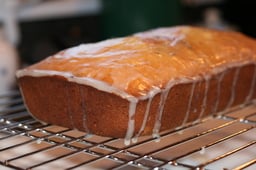My friend April shared a (very) generous drizzle of this precious vanilla ore with me, and I’m not sure I’ll ever go back to extract – or heaven forbid, “vanilla flavoring.”
The paste is used 1-1 in recipes that call for vanilla extract, but it packs even more of a vanilla punch because it contains both pure extract (made when vanilla beans are pureed and macerated in ethyl alcohol and water) and vanilla seeds (the treasure you get when you scrape the inside of a long skinny vanilla bean). The seeds are major flavor-storehouses, and they also lend that “real vanilla” appearance to your ice creams, custards, and cakes.
Vanilla paste contains gum tragacanth, which is what thickens it–this can come in handy if you don’t want to add liquid to a delicate recipe. It contains sugar, which makes me want to stir a bit into a glass of milk or cup of tea immediately. And best of all, unlike actual vanilla beans, which can dry out, vanilla paste lasts indefinitely. Not that mine will last long (is dabbing it behind the ears allowed?)…..
Like so many flavorful seed pods, vanilla has health benefits too. In medieval times, it was believed to be an aphrodisiac and fever reducer. Today, vanilla essential oil is used by aromatherapists as everything from an antioxidant to an antidepressant.
Vanilla paste is not cheap (having a friend to share with is highly recommended!), but at a time when simple pleasures go a long way, I think it’s a worthwhile investment in sweet-scented foodie joy.
Have you tried vanilla bean paste? Favorite recipes welcome….


